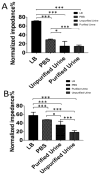Rapid Real-Time Antimicrobial Susceptibility Testing with Electrical Sensing on Plastic Microchips with Printed Electrodes
- PMID: 28291334
- PMCID: PMC5695042
- DOI: 10.1021/acsami.6b16571
Rapid Real-Time Antimicrobial Susceptibility Testing with Electrical Sensing on Plastic Microchips with Printed Electrodes
Abstract
Rapid antimicrobial susceptibility testing is important for efficient and timely therapeutic decision making. Due to globally spread bacterial resistance, the efficacy of antibiotics is increasingly being impeded. Conventional antibiotic tests rely on bacterial culture, which is time-consuming and can lead to potentially inappropriate antibiotic prescription and up-front broad range of antibiotic use. There is an urgent need to develop point-of-care platform technologies to rapidly detect pathogens, identify the right antibiotics, and monitor mutations to help adjust therapy. Here, we report a biosensor for rapid (<90 min), real time, and label-free bacteria isolation from whole blood and antibiotic susceptibility testing. Target bacteria are captured on flexible plastic-based microchips with printed electrodes using antibodies (30 min), and its electrical response is monitored in the presence and absence of antibiotics over an hour of incubation time. We evaluated the microchip with Escherichia coli and methicillin-resistant Staphylococcus aureus (MRSA) as clinical models with ampicillin, ciprofloxacin, erythromycin, daptomycin, gentamicin, and methicillin antibiotics. The results are compared with the current standard methods, i.e. bacteria viability and conventional antibiogram assays. The technology presented here has the potential to provide precise and rapid bacteria screening and guidance in clinical therapies by identifying the correct antibiotics for pathogens.
Keywords: antibiotic resistant pathogen; antibiotic susceptibility test; electrical sensing; flexible electronics; screen-printed electrodes.
Conflict of interest statement
Figures






References
-
- Chait R, Craney A, Kishony R. Antibiotic interactions that select against resistance. Nature. 2007;446:668–671. - PubMed
-
- Antibiotic Resistance Threat in the United States. Centers for Disease Control and Prevention; [accessed November 12, 2016]. http://www.cdc.gov/drugresistance/pdf/ar-threats-2013-508.pdf.
-
- Bush K, Courvalin P, Dantas G, Davies J, Eisenstein B, Huovinen P, Jacoby GA, Kishony R, Kreiswirth BN, Kutter E, Lerner SA, Levy S, Lewis K, Lomovskaya O, Miller JH, Mobashery S, Piddock LJ, Projan S, Thomas CM, Tomasz A, Tulkens PM, Walsh TR, Watson JD, Witkowski J, Witte W, Wright G, Yeh P, Zgurskaya HI. Tackling antibiotic resistance. Nat Rev Microbiol. 2011;9:894–896. - PMC - PubMed
-
- Besant JD, Sargent EH, Kelley SO. Rapid electrochemical phenotypic profiling of antibiotic-resistant bacteria. Lab Chip. 2015;15:2799–2807. - PubMed
Grants and funding
LinkOut - more resources
Full Text Sources
Other Literature Sources

